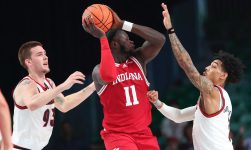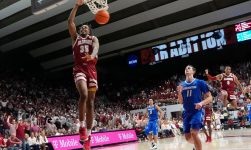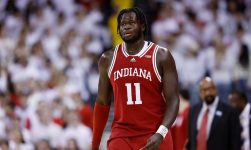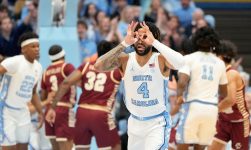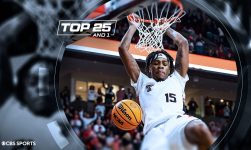The NBA Draft is less than a month away and we’ve got as compelling of a three-man debate for the No. 1 pick as there has been in a long time.
By the time the calendar moves to within a month of the NBA Draft, the discussion surrounding who’s expected be the first pick is normally almost always about one or two people. Be it in NBA circles or in media coverage, seldom is the case where there are even three viable candidates of near-equal regard in the mix to go No. 1. Sometimes that’s due to groupthink, and in other instances there really is just one guy (LeBron James, Anthony Davis, Zion Williamson) who so obviously has separated himself from all others at the time of the draft.
But 2022 is different. For the past couple of months, NBA general managers and their scouting departments have been building out their big boards and assembling order for the best prospects. No two boards are alike, and at the top of each of them is almost certainly one of three names: Jabari Smith Jr., Chet Holmgren or Paolo Banchero. A big reason for that: they’re all big men. Smith, Holmgren and Banchero all stand 6-10 or taller. To have three players of this caliber and none in the conversation be a guard or prototypical wing/small forward is abnormal. (There is a chance Jaden Ivey could be lurking atop a team or two’s board, but generally speaking he’s not being placed on the same tier as the other three going into the draft.)
With this, the Orlando Magic are blessed and cursed. No matter who the organization takes No. 1, there’s a solid chance that even if their first pick turns out to be quite good, one or both of the other two could wind up as better players. Oklahoma City and Houston are quite happy to be where they are.
If you’re taking someone No. 1, especially in this draft, you’re taking what you see as a franchise-altering player. No moving off that point. This isn’t a “down year” for the draft. There’s a lot of variety and a lot of proven commodities available, starting with Orlando’s first selection. A franchise pillar, a super-max guy on his second contract: that’s what’s at stake here. Orlando needs to determine if Smith, or Holmgren, or Banchero best carries all those attributes. This franchise is desperately in need of a player who can change the course of its trajectory the same way Shaquille O’Neal and Dwight Howard did when they were selected first overall by the Magic in 1992 and 2004, respectively.
Orlando has an enviable task. The hit-rate probability on all three of these players seems high, but history suggests otherwise. It’s a lot to take in for the future of a franchise that hasn’t won a playoff series since 2010.
Orlando almost certainly still hasn’t made its decision on who it will be taking at No. 1 — it won’t meet with these top prospects and hold team workouts until later in June. As the Magic’s front office tries to filter out everything about each player in the lead-up to the draft, we wanted to give you an all-in-one-place evaluation primer on why Smith, Holmgren and Banchero are up for debate. There are convincing cases to make for each of these players, not just to go No. 1, but to be eventual superstars. This trio to pick from is so collectively good and so uncommon, we might not see another three-way push for the top pick like it for a generation.
Who will be called first by Adam Silver on June 23? Let’s explore why Smith, Holmgren and Banchero are compelling big-man prospects. Some of the information and evaluations below are based off of on-background conversations with NBA personnel.
Jabari Smith Jr. | Auburn | PF
Smith’s NBA Draft breakdown
After winning this month’s lottery, the Magic have reportedly taken an early liking to Smith, Auburn’s one-and-done combo forward, as he’s retained his standing as the favorite in betting markets to be this year’s top pick.
Smith’s got the pedigree to be the first name called on draft night, that’s for sure. He was the No. 2 prospect at his position coming out of high school in the 247Sports Composite rankings and the winner of the MaxPreps Georgia Player of the Year as a high school senior. The former five-star is also the son of long-time NBA big man Jabari Smith, a second-round pick in 2000 who spent five seasons in the NBA and another five playing abroad.
On the court Smith has more than validated the pedigree as well as a clear top prospect in this draft. In one season with Auburn he averaged a team-high 16.9 points for a Tigers squad that earned a No. 2 seed in the NCAA Tournament. He also led his roster among regular contributors with a 42% hit rate from 3-point range, emerging not just as one of the best shooters at his position but across all positions in college hoops. His 3-point shooting percentage was second-best among all freshmen who took at least five per game and fifth-best among players in the major seven conferences regardless of classification. He made scoring from distance in the SEC look like he was playing Pop-a-Shot.
The stroke is undeniable. To hear college coaches and scouts talk about Smith, that ever-sought four-word refrain for any high-end prospect comes up plenty: he looks the part.
“He doesn’t have much of a hole [in his game],” one NBA scout told CBS Sports. “What he did and how much he continued to improve throughout the course of the year. I guess you can ask about the rebounding or if he can be your No. 1 on a championship team, but he also did a pretty good job of answering each of those questions the last month of the season.”
And so it should come at no surprise that, at 6-foot-10 and with a 7-1 wingspan, Smith’s shooting is the selling point here at No. 1. He rated in the 94th percentile among all college players as a freshman in spot-up shooting situations, according to Synergy Sports data. In catch-and-shoot situations, he was in the 84th percentile. His shooting accuracy and consistency helped him become just the second 6-10 (or taller) college player ever — joining Kevin Durant (hello!) — to make at least 100 free throws and 60 3-pointers in a single season. (Smith finished with 131 made free throws and 79 made 3-pointers. Durant at Texas in 2006-07 finished with 209 and 82, respectively.)
“I actually think Jabari is the most developed and has the highest floor because of the way that he can score in the half court and also not demand and dominate the ball as much as maybe Paolo does,” the scout said.
How diversified Smith can score is another question entirely that at the very least may cause NBA teams to pause in projecting him and his potential bona fides to become the first pick. What will Orlando see here? An ESPN stat that aired early in Auburn’s final regular season game revealed that at the time, 74% of his made baskets were made either after taking zero dribbles or only taking one dribble. He was used almost exclusively as a catch-and-shoot threat at Auburn. A really good one, of course, but the array in which he scored baskets was pretty limited on the whole. Not a lot of dribble pull-ups. Limited playmaking. Just a dead-eye shooter. Synergy recorded 23 half-court possessions last season where he took shots off the catch while unguarded — and he rated in the 100th percentile. He nearly averaged 2.0 points per shot (1.957, to be precise) in those instances. That was No. 2 among high-major college hoops players last season.
“Jabari will go in as the best jump-shooting big in college basketball over the last 10 years,” Auburn coach Bruce Pearl said in April after the season came to an end. “Just wait until he’s 19. Just wait until he’s 20 and his body just begins to normally mature and develop. He’s the first NBA All-Star that I’ve had. Tobias Harris was close, and Isaac Okoro maybe could get there. But he’s an NBA All-Star.”
The shooting expertise is only a sample of what he brings to the table. On defense he played next to the No. 2 shot blocker in the country, Walker Kessler, and yet he still averaged 1.0 blocks and 1.1 steals. His fluid movement allowed him to guard 1 through 5. He held his own paint to the perimeter. As he gets stronger, he could be a lethal small-ball five man on defense. There’s no gaping holes in his game.
“He’s mentally tough. He’s confident,” added Pearl. “He’s not afraid of the moment.”
Smith’s been knocked (slightly) for lacking an alpha-type mentality. With Holmgren and Banchero, that’s not a concern. There is no perfect prospect, but the reason Smith is the favorite as of now to go No. 1 is his combination of size, athleticism, two-way capability, near-perfect shooting form and mental aptitude for the game. He looks like what a modern NBA star should look like. Still, he’s not a complete player yet, and there were times when he’d disappear for long stretches in games.
Depending on how Oklahoma City and Houston rate Jaden Ivey, there are scenarios in which Holmgren or Banchero could be drafted as high as No. 1 or wait until No. 4. With Smith, he’s not falling below third. His window to be selected is the smallest of any prospect in the class, and as of this publishing, he’s perceived as the most likely guy to be first off the board.
Chet Holmgren | Gonzaga | C
Holmgren’s NBA Draft breakdown
You won’t find across-the-board agreement on many things with top prospects, but one area where people in basketball circles find common ground is the notion that Holmgren has the highest ceiling of any player in the 2022 class. The lanky big from Minneapolis is 7 feet tall and listed at 195 pounds with a 7-6 wingspan. As we chronicled in the middle of his one-and-done season at Gonzaga, he’s a one-of-a-kind player. Holmgren is as tempting as he is petrifying for NBA general managers.
“He scares the shit out of me,” one NBA scout on a team with a top-five pick told CBS Sports.
If you draft him, you could get burned; if you pass on him, you could get torched. While this is fundamentally true of most players in consideration for the top pick each year, the decision surrounding Holmgren is different from most because he looks and plays differently from most. Because he’s unique, there will be more scrutiny on where he’s picked than any other player. If it all comes together for Holmgren, he’ll have the perimeter scoring prowess to average north of 20 points, while having the defensive aptitude to rank among the best rim protectors the NBA has ever seen. In short: He’ll be a Hall-of-Famer if his body doesn’t betray him and his playing style can be fully exploited.
He’s also basketball-obsessed. He doesn’t take compliments well and demands to be coached hard. Always. Being the No. 1 pick shouldn’t change that mindset.
What to do, then? Among the players in the running to be picked in the top five, Holmgren is perceived as having the widest gap between his floor and ceiling. For as solid as his freshman season was at Gonzaga, he’s still in some ways an unknown because there’s no template to pull from. One area that will cause Orlando to hesitate with taking him first is Holmgren’s inability to consistently raise his game against the toughest competition he faced last season. Against the best teams Gonzaga played, Holmgren on average had his worst numbers. The drops in production and efficiency aren’t drastic but they are notable. Tiers A and B below are per KenPom.com’s parameters, meaning those tiers were the better opponents per predictive team metrics.
Holmgren vs. Tier A teams (14 games): 25.6% 3-point shooting, 70.5% 2-point shooting, 11.6 points, 10.1 rebs, 3.5 blocksHolmgren vs. Tier A and Tier B teams (16 games): 30.0% 3-point shooting, 71.6% 2-point shooting, 12.3 points, 9.9 rebs, 3.7 blocks
Holmgren vs. all opponents (32 games): 39% 3-point shooting, 73.7% 2-point shooting, 14.1 points, 9.9 rebounds, 3.7 blocks
The good news is the defense seldom disappeared. Holmgren’s instincts and stats are undeniable. While nine of his 32 games did end with him logging four or five fouls, his penchant for fouls wasn’t debilitating. In fact, it could be argued college officials had challenges adjusting to how to officiate Holmgren. He is not just a natural shot-blocker; it’s his instinct to erase space and be an ever-lurking threat thanks to his no-you-don’t weakside recovery gambits. No one is close to him as a shot-blocker in this class. One scout said Holmgren’s capacity to cover ground and tilt Gonzaga’s defense was better than almost any player to come into the league in the past 10 years. Even if Holmgren doesn’t wind up as the best player in 2022’s crop — even if he doesn’t prove to live up to his potential — he could still average three blocks per game for his NBA career. That defensive dependability brings a lot of mileage to his value. To simplify one basketball axiom, for every shot he blocks, another three never even get attempted.
Holmgren’s also a catch because he’s got guard-like handles. He can snare a defensive rebound, immediately put the ball on the floor in traffic and gallop in transition toward either a stop-and-pop 3 or a rim-run finish. While the latter isn’t Giannis-esque for Holmgren, he nonetheless possesses ball-handling skills for a big that few other 7-footers are capable of.
The biggest hesitation is of course his frame. He’s listed at 195 pounds, but despite adding to his muscle tone at Gonzaga, Holmgren’s still skinny to the point where it concerns evaluators. Some might look at ever-slender Kevin Durant as a counterargument, but to hear some scouts rebut this, it’s crucial to realize Holmgren is not Durant and won’t be asked to play the way Durant does. (So don’t even go there.) The one area where those two have the biggest similarity is their obsessive obedience to the game. Holmgren is maniacal about staying in the gym, so much to the point where he had to seriously be held back from overworking himself at Gonzaga.
The question lingers: Will the concerns about Holmgren wind up mirroring the concerns about Zion Williamson? Multiple scouts told CBS Sports that, despite Holmgren never being injured, the NBA’s physicality still gives them pause. Williamson was arguably the best one-and-done college player ever, but despite being the consensus No. 1 pick in 2019, the only thing that loomed over him was how he was holding weight and if that would be an issue in the NBA. It was the singular concern. It turned out to be a viable one. Williamson has played in only 85 games as a New Orleans Pelican.
“We could have this unique shot-blocker and shot-maker that maybe the league has never seen before with his size and ball skills,” a scout said. “The body is the copout, I guess, for what he can be and not be, and what might deter him.”
Holmgren’s toughness isn’t in question. But his strength and the long-term projections on his body type are aggressively up for debate. What if durability skepticism winds up being proven correct? Smith and Banchero have NBA-ready physiques. Holmgren is a 7-foot riddle in this regard. Plus, will he get pushed off the floor? He’s tough but he’s not strong. He can be bullied, and he’s at best a B-level on-ball defender in space. Will foul issues be perpetual once he’s playing against much larger, faster and stronger competition, the likes of which he’s barely encountered to this point in his life? If Holmgren doesn’t go No. 1, these are the reasons he’ll wind up waiting a few more minutes on draft night.
Some NBA evaluators also believe Holmgren finishes fourth, behind Ivey, Smith and Banchero, when it comes to creating offense. All these guys can score in myriad ways, but Holmgren’s points will most frequently come from 3-point range (a wonderful thing to add to any offense, to be sure), put-backs, lobs or scrap-like opportunities near the rim. He’ll score plenty, but it won’t come as easily for him as the other three. Holmgren’s height and fluidity at shooting 3s in all facets (transition, off the catch and off the bounce) is his most important offensive skillset. But he doesn’t have burst on offense.
Nevertheless, Holmgren will be seriously considered to go first to Orlando because he has the potential to be one of the best defensive players in the league who also possesses a reliable 3-point shot and will provide a mismatch on the floor that no other team will offer. Holmgren can handle the ball exceptionally well in transition. He’s confident and carries a toughness that belies his frame. In speaking to scouts, a common refrain is the intrigue and quizzical-ness over Holmgren’s embrace of physical play — yet he never gets hurt. Can this continue, or will we look up in three years and see he’s missed 40% of his games?
If the Magic draft Holmgren, they could be getting a franchise-changing player who ultimately makes the Hall of Fame and helps change the course of the franchise for the next 10-plus years. That’s the sell. He’s got so much to offer offensively and defensively, and there are some at the NBA level who believe he didn’t come close to revealing his full arsenal while at Gonzaga (where he played alongside All-American Drew Timme). Alternatively, if the Magic draft Holmgren there’s a non-zero chance he busts. They could pick a player who is an inconsistent physical specimen, someone whose body and abnormal scheme fit could lead to him not being one of the five-to-10 best players from this class.
If you’re a GM or team president, Holmgren can get you fired just as easily as he can make your career.
Paolo Banchero | Duke | PF
Banchero’s NBA Draft breakdown
No player in the discussion to go No. 1 has more all-around offensive bona fides — more variety to his game — than Banchero. If he was graded a little higher on defense, Banchero would probably be the favorite to get picked first. Despite his defensive reputation (more on that below), he can still get there. There is a persuasive case for the Magic to draft him.
What do you want out of the No. 1 pick? The player who projects as the best, naturally. But it’s more than that. It’s someone who fits a franchise’s philosophy and someone who can handle all the pressure, opportunity and distraction that comes with having a 1 next to their name forever. In this realm, no one can match Banchero in the 2022 class, at least in terms of being in the spotlight and cresting to this moment. He’s been regarded as a top-shelf pro prospect longer than Smith, Holmgren, Ivey or anyone else who will go in the lottery. Both his parents were Division I athletes; his mother also played in the WNBA. Banchero was pegged as a potential lottery talent by the age of 15. He’s never given evaluators reason to balk, improving steadily over the past four years. Plus, he played under high-pressure circumstances last season when he shined during Mike Krzyzewski’s final tour as the coach of Duke, taking his game to yet another level in the NCAA Tournament and helping push the Blue Devils to the Final Four.
Banchero is wired for this.
Banchero will be a next-level scorer, but what else can he do to set himself apart? Listen below and subscribe to Eye on College Basketball.
“Somehow he’s the one that kind of flew under the radar,” one NBA scout said. “If that is at all possible with a prospect out of Duke. You have a unicorn with Chet and this shot-making savant who takes over the field with Jabari. Paolo is the best half-court offensive cog there is. It comes down to the defense and if he can and wants to improve at it and to what level he can get it to. Does his offense overcome his major deficiencies on that end and what other type of big can he play next to? Is (Mo) Bamba the right fit for him? His lack of length and shot blocking kind of pigeon holes him into the 4 at times.”
He was surrounded by a lot of talent at Duke, yet pulled off something that’s a lot harder than it looks. Banchero managed to be Duke’s best player while simultaneously showing he can star just as easily as he can play a role. His averages: 17.2 points, 7.8 rebounds, 3.2 assists and a 52.0% effective field goal percentage. At 6-10 and approximately 250 pounds with a 7-1 wingspan, Banchero has the best frame and body type — it projects to be the safest going forward, anyway — of the three players at hand. He’s strong but not too bulky. He has thick legs and a reliable base, but he’s pliable. His athleticism isn’t top-notch, but his craftiness, knack for cutting and basketball intelligence easily make up for not having freak-like instincts and twitchiness. Banchero’s endurance improved as the season went along, too. Smith is the better athlete, Holmgren is the more tantalizing player, but Banchero’s figured out and proven more than those two at this stage.
How much more room is there for him to grow? Plenty, though there is disagreement about how much. For some NBA folk, Banchero has a high floor — maybe the highest of anyone in the draft — but potentially a lower ceiling than Smith or Holmgren. Maybe even Ivey, Keegan Murray or Shaedon Sharpe, too. There are concerns tagged to him that get tagged to some guys who are regarded as top-five material, like: Will he ever be as productive in the NBA at the same level he was in college? Banchero was the CBS Sports National Freshman of the Year and objectively a top-10 player in the sport. Is he ever going to be as valuable in any NBA season as he just was at Duke?
He could be good to go right away. No matter where he lands, Banchero’s adaptability will put him in a position to thrive as 2023 NBA Rookie of the Year frontrunner. The Seattleite has nearly a full arsenal on offense. He can square up and shoot. The form looks good, if a smidge flat upon release. Banchero scores at all three levels with proportional efficiency. He can work with his back to the basket, both with patience and with haste. In fact, even though the art of the post-up is losing cachet by the year, it will never entirely go out of style. We could look up in 2026 and see back-to-the-basket technique still having a place in NBA ball, meaning Banchero’s dynamic array of attacks could make him an All-Star relatively early in his career.
Banchero is capable of creating off the dribble. What he can do at 6-10 and 250 now would have been considered mind-blowing 15 years ago. Now it’s taken a bit more for granted. He’s a clear-cut tier below what LeBron James was coming out of high school 19 years ago, but it’s easy to see how Banchero has modeled some of his style after what James does. He can score from the perimeter with a respectable first step and uses that threat to deploy one of the better spin moves we’ve seen from a big-man prospect in recent years. As Banchero goes through the workout circuit with top teams in the coming weeks, he’s bound to make general managers and scouts swoon. It’s evident how much is already there.
According to Synergy, Banchero scored 1.44 points per shot on cuts, ranking in the 92nd percentile in Division I. From the midrange, Banchero averaged a point per shot on 2-point shots when shooting from 17 feet out to the 3-point line. On pick-and-pops, 1.2 points per shot. He can shoot and score (as any basketball person worth their salt will tell you, they are two different skill sets) through his own creation or via others, though he’s not yet excelled as a catch-and-shoot guy the way Holmgren and Smith can.
One thing that private workouts won’t simulate: Banchero’s next-level passing ability. He’s a passer who’s always looking to get better in how he passes. Some believe Banchero will grow into being one of the five-or-so best passing bigs in the NBA by the end of his first contract. His ability and willingness to move the ball in Duke’s scheme helped make the Blue Devils one of the best teams in the country. The fact that Banchero can score in a dozen or more ways but doesn’t command the ball purely to shoot is a major selling point. He can have the offense run through him or he can be used to lubricate sets and keep defenses shifting. Definition of a dynamic big who can play the 3, 4 or 5. Carmelo Anthony was a clear-cut top-three pick 19 years ago, and Banchero’s similarly developed at this stage (the shooting percentages are near-identical) to what Anthony was then (though Anthony was unquestionably a better scorer).
Defensively, there will be work to do. Banchero isn’t a top-30 defender in this draft, but some of that is accentuated by the fact he played alongside Mark Williams and Wendell Moore Jr., who were two of the 15-or-so best defenders in the country. Banchero’s lateral movement is average. The switchability is acceptable, but he will likely never be a player who can guard four or more positions reliably. He also isn’t a high-vertical rim protector, and the question with Banchero that lingers is, if he’ll wind up guarding centers, will he have the athleticism and length to do that as a plus defender? Many are skeptical.
“You just worry [his defense] declines even more and whenever you’re asking that guy to be on the floor 35-plus minutes per game, you don’t want to make it a bloodbath,” a scout said.
Still, all he’ll bring offensively will mostly offset these defensive drawbacks.
A common piece of feedback we’ve heard since the college season ended: Banchero makes this a true three-horse race because he seems the least likely to be a bust of any projected high-end player in this draft. He’s a big, smart, good teammate, improving 3-point shot, someone who can be molded to an offense instead of vice-versa. His best asset is how he knows when to fluctuate between using his brute-force style to bully-ball and when to deploy some touch and grace. Sometimes he’ll do it all on the same possession. The debate is ongoing about whether Banchero is the best prospect, and a lot of that is based in something that’s hard to refute: he certainly seems like the safest pick of them all.
All three of these guys are built for the modern NBA. Who will be built to be great five, seven, 10 years from now/ Orlando has less than a month to figure that out.

